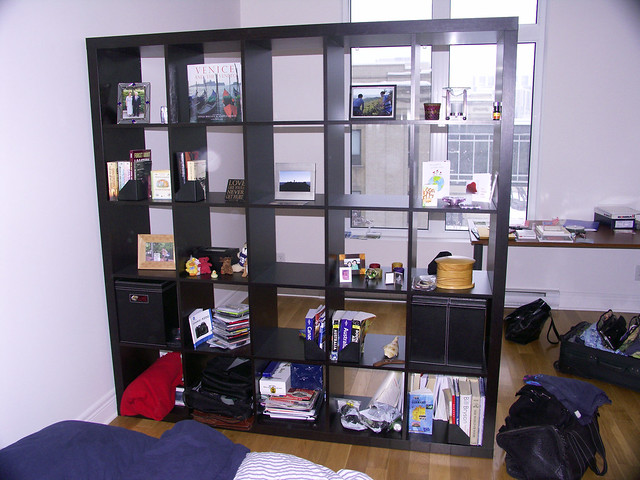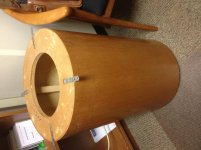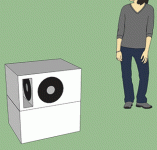Newegg is doing 10" Polk subs for $99 each today:
Polk Audio PSW Series PSW10 Black Each Home Audio Speaker - Newegg.com
This isn't a raw driver; it's a finished sub with an amplifier and an enclosure.
IMHO, this is one of the easiest/cheapest ways to try the multi sub approach.
For about a year I did something similar with a Kef sub. About the only drawback to the setup was that I had to wire all my subs in series parallel. (IE, I had to take the Kef sub apart, then put the other subs in series -parallel with the KEF, using the KEF amplifier to power *all* the subs.)
The reason I had to go through all this hassle was because I was getting a nasty ground loop when I used more than one sub amp. YMMV.
Polk Audio PSW Series PSW10 Black Each Home Audio Speaker - Newegg.com
This isn't a raw driver; it's a finished sub with an amplifier and an enclosure.
IMHO, this is one of the easiest/cheapest ways to try the multi sub approach.
For about a year I did something similar with a Kef sub. About the only drawback to the setup was that I had to wire all my subs in series parallel. (IE, I had to take the Kef sub apart, then put the other subs in series -parallel with the KEF, using the KEF amplifier to power *all* the subs.)
The reason I had to go through all this hassle was because I was getting a nasty ground loop when I used more than one sub amp. YMMV.
Trouble with this approach, and I have been there, is that the linear range of operation is so low that it can take many many of them to get sufficient headroom. Consider that 6 dB more headroom requires that you double the number. A good sub can easily have 12-18 dB more headroom than one of these inexpensive ones. That means it could be 8 to 16 of these to equal what two high output subs (like mine) will do.
With cheap drivers, one can also use design to improve the situation, for subs. I utilize some "value" subwoofer drivers (they're actually not terrible, and were <$20 per 12" on clearance) in a dual isobaric arrangement- force cancellation via a semi-opposed (right angle) mounting, and isobaric for lower even order distortion. You can fit 2 isobaric pairs into one enclosure of the same volume requirement as a single woofer, same efficiency, and twice the displacement and 4x power handling, which means much less distortion of any type for a given SPL, compared to a single woofer of the same type.
I use 2 of these, which gives an octet of 12"s but only 4 12"s worth of displacement. By using 2 drivers (or clamshell isobaric pairs) on a given enclosure, you gain a small amount of location distribution. Not enough to make a huge difference, but with high Q room behavior, sometimes a small change can make a relatively large difference.
I use 2 of these, which gives an octet of 12"s but only 4 12"s worth of displacement. By using 2 drivers (or clamshell isobaric pairs) on a given enclosure, you gain a small amount of location distribution. Not enough to make a huge difference, but with high Q room behavior, sometimes a small change can make a relatively large difference.
Random observation:
At one point I had eight subs, and it definitely sounded better than the three sub setup. That was in a house that's 2800'.
About two years back I moved to the Seattle area, and moved into a house that was about half the size. Due to the smaller space, I went down to three subs. Definitely not as good as eight, but still quite good.
Fast forward to a couple months ago, and I moved *again.* New place is even *smaller.*
For the life of me, I am having a heck of a time figuring out how to squeeze two Summas and three subs into my living room.
But I did another thing Geddes suggested, which is to vary the height of the subs. And this seems to make a bigger difference than I'd expected. Right now I am only running two subs, but one of them is about 5' off the floor. And I'd say that localization of the two sub setup is a bit better than my three sub setup, where all three subs were on the floor.
Again, this is far from a scientific study, but if you have a way to get one of your subs off the floor, give it a try.

I have one of my subs in the top shelf of a 5x5 Expedit cabinet. ($199 at Ikea.)
In order to make sub fit, I removed one of the dividers.
At one point I had eight subs, and it definitely sounded better than the three sub setup. That was in a house that's 2800'.
About two years back I moved to the Seattle area, and moved into a house that was about half the size. Due to the smaller space, I went down to three subs. Definitely not as good as eight, but still quite good.
Fast forward to a couple months ago, and I moved *again.* New place is even *smaller.*
For the life of me, I am having a heck of a time figuring out how to squeeze two Summas and three subs into my living room.
But I did another thing Geddes suggested, which is to vary the height of the subs. And this seems to make a bigger difference than I'd expected. Right now I am only running two subs, but one of them is about 5' off the floor. And I'd say that localization of the two sub setup is a bit better than my three sub setup, where all three subs were on the floor.
Again, this is far from a scientific study, but if you have a way to get one of your subs off the floor, give it a try.

I have one of my subs in the top shelf of a 5x5 Expedit cabinet. ($199 at Ikea.)
In order to make sub fit, I removed one of the dividers.
Now we're talking about something I've recently discovered is important: going to heterogeneous subs. The idea is to have a single (mixed) bass but to drive subs as different in type and location as possible, including height as Geddes suggests.... corner, mid-wall, sealed, ported, big, little....
(OK, maybe I wouldn't go so far as to suggest TH)
I know this makes people with the heart of an engineer queasy (or should I say stomach) but in other areas of design, using a mix that achieves a good end-result (sometimes better than an average result) makes sense (like in the stock market).
But even just averaging can be very helpful when we are talking about the incredible peaks and dips in a real-world music rooms when a single or just two matched subs are used.
My "theory" may not make sense to people who incorrectly believe you have material sound localization down to low frequencies on music.
Ben
(OK, maybe I wouldn't go so far as to suggest TH)
I know this makes people with the heart of an engineer queasy (or should I say stomach) but in other areas of design, using a mix that achieves a good end-result (sometimes better than an average result) makes sense (like in the stock market).
But even just averaging can be very helpful when we are talking about the incredible peaks and dips in a real-world music rooms when a single or just two matched subs are used.
My "theory" may not make sense to people who incorrectly believe you have material sound localization down to low frequencies on music.
Ben
Last edited:
I tested the effect of an auxiliary sub. Both in simulation and IRL. Simulation suggested that best placement was the opposite wall, but it didn't work out well. I put it on top of a bookshelf (near the ceiling) and middle of side wall. This was best of the test for me.
Besides speakers in distributed height, we must always remember to make measurements from various mic positions (including height) before making judgements!
simulations www.hunecke.de
Besides speakers in distributed height, we must always remember to make measurements from various mic positions (including height) before making judgements!
simulations www.hunecke.de
Besides speakers in distributed height, we must always remember to make measurements from various mic positions (including height) before making judgements!.de
Best to stay near the middle of the room however. At "subwoofer" frequencies the differences in space are not that great, but yes, some average in space is always advised.
My current setup has 2 dual isobaric 12"s- but keeping an eye on some of our tables being decomissioned at work has paid a dividend:
Free 5/16" ply veneered shell for a pseudo-sono-sub. My plan is to put isobaric pairs on either end and do the best job of force cancellation I can to keep from having to "build up" the existing walls. There is some bracing already present that I can leverage, however.

By having a driver on either end there's a bit of spatial separation, and I'll be setting this on top of one existing cabinet that's side-firing, so there'll be 3 sources each separated by a couple feet.
Free 5/16" ply veneered shell for a pseudo-sono-sub. My plan is to put isobaric pairs on either end and do the best job of force cancellation I can to keep from having to "build up" the existing walls. There is some bracing already present that I can leverage, however.

By having a driver on either end there's a bit of spatial separation, and I'll be setting this on top of one existing cabinet that's side-firing, so there'll be 3 sources each separated by a couple feet.
Attachments
This looks like two issues so, with regard to location it would seem to need more subs to make it work than other ways, what does it offer?. And with regard to type, what do you do with the differing responses between them?heterogeneous subs. The idea is to have a single (mixed) bass but to drive subs as different in type and location as possible,
In your room, each woofer and each location has a distinct sound. You want to mix-and-match.This looks like two issues so, with regard to location it would seem to need more subs to make it work than other ways, what does it offer?. And with regard to type, what do you do with the differing responses between them?
Ben
What kind of simulation provides that kind of intelligence?snip
I tested the effect of an auxiliary sub. Both in simulation and IRL. Simulation suggested that best placement was the opposite wall
snip
Ben
In your room, each woofer and each location has a distinct sound. You want to mix-and-match.
Ben
You want that mix to produce the flattest response with the lowest ringing. Simply mixing different subs won't get you there. A good method seems to be Welti's SFM. Please see http://www.aes.org/e-lib/download.cfm?ID=13680&name=harman
What kind of simulation provides that kind of intelligence?
Ben
The latest REW beta 17 has a room simulator. Also check out http://www.diyaudio.com/forums/multi-way/241449-new-program-room-response-simulation.html
What kind of simulation provides that kind of intelligence?
Ben
hunecke.de | Loudspeakers Calculator
enable Java application
You can simulate mains and up to 4 subs. Each speaker can be positioned in 3D and mic too. Nice! Choose speakers from the list (ones that have performance closely to your own)
Actually the program does not make any suggestions.. But by moving the sub #2 around I just watched how the summed response behaves.
Last edited:
Very interesting. Thanks for the education. Very interesting. Much to think about.
Lucky me, I've only fussed with a single good seat over the past 56 years of my HiFi set-ups (granted, the first 10 years were mono).
These room models (and the CABS research too) are geometry calculators intended to address what for many must be the most basic issue: flat frequency response (esp. over a broad listening area). Yet all my life (till now?), i've been thinking about speaker placement considerations which only partly intersect with eigentone matters.
It would be really nice to have a room with more than 50% of the wall area fitting the model (not my over-furnished heavily draperied rooms). And speakers in small boxes that can be put anywhere you want (not like my large bipolar ESLs, Klipschorn corner horn, and giant OB sub screwed to the wall under a table).
Final thought: a mic will reveal the terrible dirty secret of room modes. Horrible to see the curves. But how come we don't hear them on music*? Just me or is it like cameras (and optical theory) being influenced by fluorescent or narrow-band lights but human eyes not the same way?
Ben
*the AR music room in Grand Central Station used to play that extended organ pedal in the second half of the Saint Saens 3rd Sym (Munch, Boston) and the walls shook just for that note played on AR3 speakers - so there are some revealing tests using music... but rare.
Lucky me, I've only fussed with a single good seat over the past 56 years of my HiFi set-ups (granted, the first 10 years were mono).
These room models (and the CABS research too) are geometry calculators intended to address what for many must be the most basic issue: flat frequency response (esp. over a broad listening area). Yet all my life (till now?), i've been thinking about speaker placement considerations which only partly intersect with eigentone matters.
It would be really nice to have a room with more than 50% of the wall area fitting the model (not my over-furnished heavily draperied rooms). And speakers in small boxes that can be put anywhere you want (not like my large bipolar ESLs, Klipschorn corner horn, and giant OB sub screwed to the wall under a table).
Final thought: a mic will reveal the terrible dirty secret of room modes. Horrible to see the curves. But how come we don't hear them on music*? Just me or is it like cameras (and optical theory) being influenced by fluorescent or narrow-band lights but human eyes not the same way?
Ben
*the AR music room in Grand Central Station used to play that extended organ pedal in the second half of the Saint Saens 3rd Sym (Munch, Boston) and the walls shook just for that note played on AR3 speakers - so there are some revealing tests using music... but rare.
Last edited:
We can hear them until they're below some level. Even when not, they don't always sound bad after setup.Horrible to see the curves. But how come we don't hear them on music*?
We can hear them until they're below some level. Even when not, they don't always sound bad after setup.
Toole points out you can hear broad envelopes but not narrow bumps in the freq compass. And by the way, people can't tell a lower-band bump from an upper-band cut.
So we need to look again at the traditional examination of eigentones that examines the distribution of room modes. When you have bunch of loudness in a somewhat broad band, say 50-65 Hz, we say "the speaker" has an awful boomy bass.
But as "broad" gets narrower, nobody notices. Which is what I said before.
Ben
Last edited:
I think my own example from the AR Music Room was actually more relevant because there are a quite a few ways for synthetic sound to be distorted from finger-tip to fold-back speakers (is that the right term?) to recording board, to speaker resonances etc.Haven't you heard a bass guitarist playing a down a scale, and each note is obviously in balance until just one jumps out at a higher level (back down for the next one)?
There are any number of hearing "phenomena" that can only be demonstrated using hand-picked stimuli. I'm not saying narrow-band effects* can't be heard under certain conditions (and I gave an example) - just not usual to hear it with music.
Ben
*I suspect narrow-band cuts are twice as hard to "hear" as narrow-band boosts, except with hand-picked stimuli.
- Home
- Loudspeakers
- Subwoofers
- Multiple Small Subs - Geddes Approach
